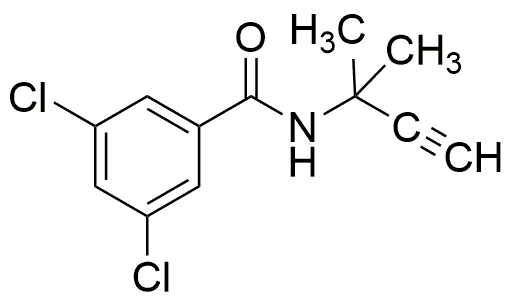Propyzamide is widely utilized in research focused on:
- Agricultural Herbicide: Commonly used in crop management, it effectively controls a variety of weeds in cereal crops, helping farmers improve yield and reduce competition for nutrients.
- Soil Residue Studies: Researchers study its degradation and persistence in soil, providing insights into environmental impact and helping to develop sustainable agricultural practices.
- Water Quality Monitoring: Employed in assessing the contamination levels of water bodies, it aids environmental scientists in understanding the effects of agricultural runoff on aquatic ecosystems.
- Plant Physiology Research: Used to study the physiological effects on plants, it helps researchers understand how herbicides influence plant growth and development, contributing to better crop management strategies.
- Integrated Pest Management (IPM): Its role in IPM programs supports sustainable agriculture by minimizing chemical use while effectively managing weed populations, addressing both economic and ecological concerns.
General Information
Properties
Safety and Regulations
Applications
Propyzamide is widely utilized in research focused on:
- Agricultural Herbicide: Commonly used in crop management, it effectively controls a variety of weeds in cereal crops, helping farmers improve yield and reduce competition for nutrients.
- Soil Residue Studies: Researchers study its degradation and persistence in soil, providing insights into environmental impact and helping to develop sustainable agricultural practices.
- Water Quality Monitoring: Employed in assessing the contamination levels of water bodies, it aids environmental scientists in understanding the effects of agricultural runoff on aquatic ecosystems.
- Plant Physiology Research: Used to study the physiological effects on plants, it helps researchers understand how herbicides influence plant growth and development, contributing to better crop management strategies.
- Integrated Pest Management (IPM): Its role in IPM programs supports sustainable agriculture by minimizing chemical use while effectively managing weed populations, addressing both economic and ecological concerns.
Documents
Safety Data Sheets (SDS)
The SDS provides comprehensive safety information on handling, storage, and disposal of the product.
Product Specification (PS)
The PS provides a comprehensive breakdown of the product’s properties, including chemical composition, physical state, purity, and storage requirements. It also details acceptable quality ranges and the product's intended applications.
Certificates of Analysis (COA)
Search for Certificates of Analysis (COA) by entering the products Lot Number. Lot and Batch Numbers can be found on a product’s label following the words ‘Lot’ or ‘Batch’.
*Catalog Number
*Lot Number
Certificates Of Origin (COO)
This COO confirms the country where the product was manufactured, and also details the materials and components used in it and whether it is derived from natural, synthetic, or other specific sources. This certificate may be required for customs, trade, and regulatory compliance.
*Catalog Number
*Lot Number
Safety Data Sheets (SDS)
The SDS provides comprehensive safety information on handling, storage, and disposal of the product.
DownloadProduct Specification (PS)
The PS provides a comprehensive breakdown of the product’s properties, including chemical composition, physical state, purity, and storage requirements. It also details acceptable quality ranges and the product's intended applications.
DownloadCertificates of Analysis (COA)
Search for Certificates of Analysis (COA) by entering the products Lot Number. Lot and Batch Numbers can be found on a product’s label following the words ‘Lot’ or ‘Batch’.
*Catalog Number
*Lot Number
Certificates Of Origin (COO)
This COO confirms the country where the product was manufactured, and also details the materials and components used in it and whether it is derived from natural, synthetic, or other specific sources. This certificate may be required for customs, trade, and regulatory compliance.


